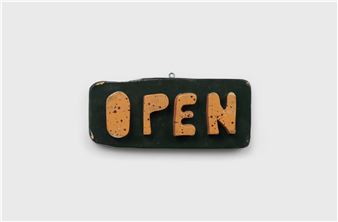Night Shift
LAMB is pleased to present Night Shift, an exhibition tracing the enduring relationship between art and the culture of nightlife, where liberation, reinvention, and moments of introspection unfold in the hours after dark. Spanning from the mid-twentieth century to the present, the exhibition brings together historic icons, including Andy Warhol and Tom Wesselmann, alongside contemporary voices such as avaf (assume vivid astro focus), Alma Berrow, Rene Mati膰, Paul-Sebastian Japaz, and Cece Philips.
The exhibition opens with the pulsating energy of Nightclubbing (2025), a vibrant large-scale painting by the S茫o Paulo-based collective avaf. Drawing from the visual language of discos, dance parties, and underground clubs, the work explodes with kaleidoscopic colour and movement that embodies the dancefloor. Rooted in queer visual cultures and shared forms of expression, avaf transforms painting into a celebratory platform for participation and connection. This collective energy finds historical resonance in Sem t铆tulo [Untitled] (1962) by Heitor dos Prazeres (b. 1898, d. 1966, Rio de Janeiro), a pioneering samba composer who later turned to painting. Dos Prazeres translated the rhythms of Afro-Brazilian life, including samba, carnival, and the rituals of everyday festivity, into dynamic compositions which showcase celebration as a profound cultural ritual and a means of shaping identity.
In the following room, the exhibition explores themes of excess, decadence, and celebrity, as well as the spaces of nightlife where they take shape. Andy Warhol鈥檚 gelatin silver prints from Studio 54 immortalise the notorious nightclub as a place of style and spectacle, and document a world where the night offered possibilities for reinvention within the club walls. As Warhol captured the living glamour of nightlife, Alma Berrow translates its aftermath and remnants. Her ceramic installation Alls Swell (2023) transforms the late-night atmosphere into sculptural forms and objects that hold the residue of the night, suggesting how nightlife leaves behind physical traces of experience.

Recommended for you
LAMB is pleased to present Night Shift, an exhibition tracing the enduring relationship between art and the culture of nightlife, where liberation, reinvention, and moments of introspection unfold in the hours after dark. Spanning from the mid-twentieth century to the present, the exhibition brings together historic icons, including Andy Warhol and Tom Wesselmann, alongside contemporary voices such as avaf (assume vivid astro focus), Alma Berrow, Rene Mati膰, Paul-Sebastian Japaz, and Cece Philips.
The exhibition opens with the pulsating energy of Nightclubbing (2025), a vibrant large-scale painting by the S茫o Paulo-based collective avaf. Drawing from the visual language of discos, dance parties, and underground clubs, the work explodes with kaleidoscopic colour and movement that embodies the dancefloor. Rooted in queer visual cultures and shared forms of expression, avaf transforms painting into a celebratory platform for participation and connection. This collective energy finds historical resonance in Sem t铆tulo [Untitled] (1962) by Heitor dos Prazeres (b. 1898, d. 1966, Rio de Janeiro), a pioneering samba composer who later turned to painting. Dos Prazeres translated the rhythms of Afro-Brazilian life, including samba, carnival, and the rituals of everyday festivity, into dynamic compositions which showcase celebration as a profound cultural ritual and a means of shaping identity.
In the following room, the exhibition explores themes of excess, decadence, and celebrity, as well as the spaces of nightlife where they take shape. Andy Warhol鈥檚 gelatin silver prints from Studio 54 immortalise the notorious nightclub as a place of style and spectacle, and document a world where the night offered possibilities for reinvention within the club walls. As Warhol captured the living glamour of nightlife, Alma Berrow translates its aftermath and remnants. Her ceramic installation Alls Swell (2023) transforms the late-night atmosphere into sculptural forms and objects that hold the residue of the night, suggesting how nightlife leaves behind physical traces of experience.

 ARTISTS
ARTISTS












